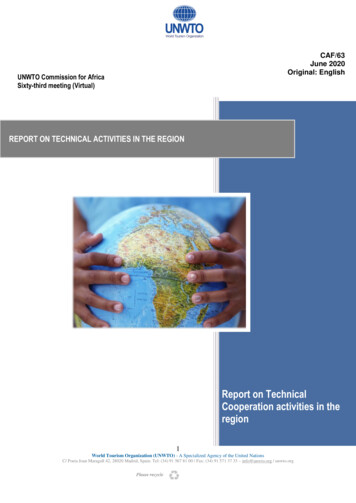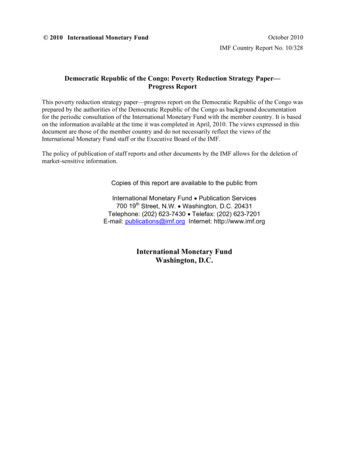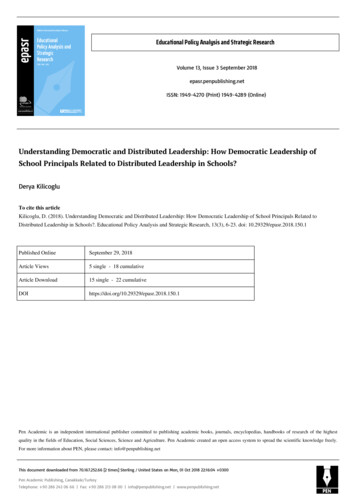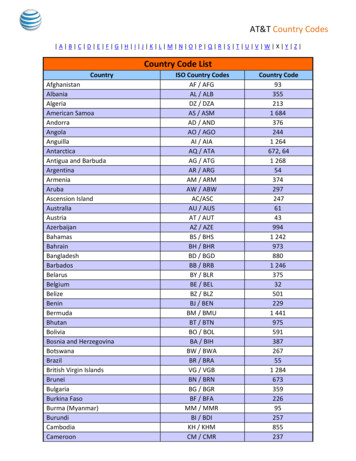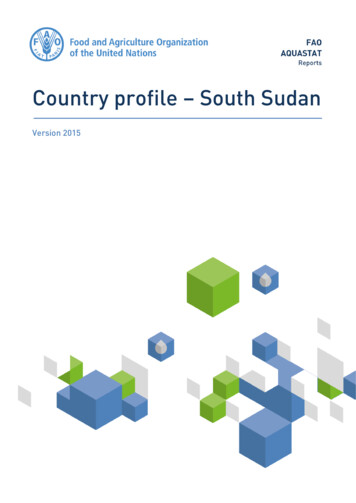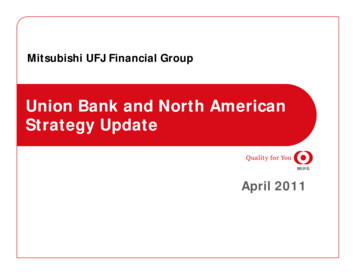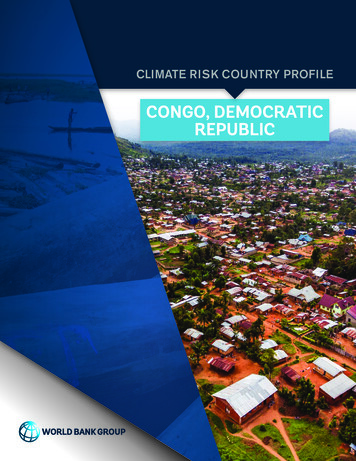
Transcription
CLIMATE RISK COUNTRY PROFILECONGO, DEMOCRATICREPUBLIC
COPYRIGHT 2021 by the World Bank Group1818 H Street NW, Washington, DC 20433Telephone: 202-473-1000; Internet: www.worldbank.orgThis work is a product of the staff of the World Bank Group (WBG) and with external contributions. The opinions, findings,interpretations, and conclusions expressed in this work are those of the authors and do not necessarily reflect the views or theofficial policy or position of the WBG, its Board of Executive Directors, or the governments it represents.The WBG does not guarantee the accuracy of the data included in this work and do not make any warranty, express or implied,nor assume any liability or responsibility for any consequence of their use. This publication follows the WBG’s practice inreferences to member designations, borders, and maps. The boundaries, colors, denominations, and other information shownon any map in this work, or the use of the term “country” do not imply any judgment on the part of the WBG, its Boards, or thegovernments it represents, concerning the legal status of any territory or geographic area or the endorsement or acceptanceof such boundaries.The mention of any specific companies or products of manufacturers does not imply that they are endorsed or recommendedby the WBG in preference to others of a similar nature that are not mentioned.RIGHTS AND PERMISSIONSThe material in this work is subject to copyright. Because the WBG encourages dissemination of its knowledge, this work maybe reproduced, in whole or in part, for noncommercial purposes as long as full attribution to this work is given.Please cite the work as follows: Climate Risk Profile: Congo, Democratic Republic (2021): The World Bank Group.Any queries on rights and licenses, including subsidiary rights, should be addressed to World Bank Publications, The World BankGroup, 1818 H Street NW, Washington, DC 20433, USA; fax: 202-522-2625; e-mail: pubrights@worldbank.org.Cover Photos: Flor de Preneuf/World Bank, “Timber floating on Congo River” May 18, 2013 via Flickr, Creative Commons CCBY-NC-ND 2.0. Vincent Tremeau/World Bank, “Aerial view of Beni, North Kivu region” January 17, 2019 via Flickr, CreativeCommons CC BY-NC-ND 2.0.Graphic Design: Circle Graphics, Reisterstown, MD.CLIMATE RISK COUNTRY PROFILE: CONGO, DEMOCRATIC REPUBLICii
ACKNOWLEDGEMENTSThis profile is part of a series of Climate Risk Country Profiles developed by the World Bank Group (WBG). The country profilesynthesizes most relevant data and information on climate change, disaster risk reduction, and adaptation actions and policiesat the country level. The country profile series are designed as a quick reference source for development practitioners to betterintegrate climate resilience in development planning and policy making. This effort is managed and led by Veronique Morin(Senior Climate Change Specialist, WBG) and Ana E. Bucher (Senior Climate Change Specialist, WBG).This profile was written by MacKenzie Dove (Senior Climate Change Consultant, WBG). Additional support was provided byYunziyi Lang (Climate Change Analyst, WBG), Fernanda Zermoglio (Senior Climate Change Consultant, WBG) and JasonJohnston (Operations Analyst, WBG).Climate and climate-related information is largely drawn from the Climate Change Knowledge Portal (CCKP), a WBG onlineplatform with available global climate data and analysis based on the latest Intergovernmental Panel on Climate Change (IPCC)reports and datasets. The team is grateful for all comments and suggestions received from the sector, regional, and countrydevelopment specialists, as well as climate research scientists and institutions for their advice and guidance on use of climaterelated datasets.CLIMATE RISK COUNTRY PROFILE: CONGO, DEMOCRATIC REPUBLICiii
CONTENTSFOREWORD . . . . . . . . . . . . . . . . . . . . . . . . . . . . . . . . . . . . 1COUNTRY OVERVIEW . . . . . . . . . . . . . . . . . . . . . . . . . . . . . . . 2CLIMATOLOGY . . . . . . . . . . . . . . . . . . . . . . . . . . . . . . . . . .Climate Baseline . . . . . . . . . . . . . . . . . . . . . . . . . . . . . . . . . . . . . . . .Overview . . . . . . . . . . . . . . . . . . . . . . . . . . . . . . . . . . . . . . . . . .Key Trends . . . . . . . . . . . . . . . . . . . . . . . . . . . . . . . . . . . . . . . . .Climate Future . . . . . . . . . . . . . . . . . . . . . . . . . . . . . . . . . . . . . . . . .Overview . . . . . . . . . . . . . . . . . . . . . . . . . . . . . . . . . . . . . . . . . .Key Trends . . . . . . . . . . . . . . . . . . . . . . . . . . . . . . . . . . . . . . . . .4446779CLIMATE RELATED NATURAL HAZARDS . . . . . . . . . . . . . . . . . . . . . . 10Overview . . . . . . . . . . . . . . . . . . . . . . . . . . . . . . . . . . . . . . . . . . . 10Key Trends . . . . . . . . . . . . . . . . . . . . . . . . . . . . . . . . . . . . . . . . . . 12Implications for DRM . . . . . . . . . . . . . . . . . . . . . . . . . . . . . . . . . . . . . . 13CLIMATE CHANGE IMPACTS TO KEY SECTORS . . . . . . . . . . . . . . . . . . . 13Agriculture . . . . . . . . . . . . . . . . . . . . . . . . . . . . . . . . . . . . . . . . . . 14Water . . . . . . . . . . . . . . . . . . . . . . . . . . . . . . . . . . . . . . . . . . . . 17Forestry . . . . . . . . . . . . . . . . . . . . . . . . . . . . . . . . . . . . . . . . . . . 19Energy . . . . . . . . . . . . . . . . . . . . . . . . . . . . . . . . . . . . . . . . . . . . 20Health . . . . . . . . . . . . . . . . . . . . . . . . . . . . . . . . . . . . . . . . . . . . 22ADAPTATION . . . . . . . . . . . . . . . . . . . . . . . . . . . . . . . . . . . 25Institutional Framework for Adaptation . . . . . . . . . . . . . . . . . . . . . . . . . . . . . 25Policy Framework for Adaptation . . . . . . . . . . . . . . . . . . . . . . . . . . . . . . . . 25Recommendations . . . . . . . . . . . . . . . . . . . . . . . . . . . . . . . . . . . . . . 26Research Gaps . . . . . . . . . . . . . . . . . . . . . . . . . . . . . . . . . . . . . . . 26Data and Information Gaps . . . . . . . . . . . . . . . . . . . . . . . . . . . . . . . . . 26Institutional Gaps . . . . . . . . . . . . . . . . . . . . . . . . . . . . . . . . . . . . . . 27CLIMATE RISK COUNTRY PROFILE: CONGO, DEMOCRATIC REPUBLICiv
FOREWORDClimate change is a major risk to good development outcomes, and the World Bank Group is committed to playingan important role in helping countries integrate climate action into their core development agendas. The WorldBank Group is committed to supporting client countries to invest in and build a low-carbon, climate-resilient future,helping them to be better prepared to adapt to current and future climate impacts.The World Bank Group is investing in incorporating and systematically managing climate risks in developmentoperations through its individual corporate commitments.A key aspect of the World Bank Group’s Action Plan on Adaptation and Resilience (2019) is to help countriesshift from addressing adaptation as an incremental cost and isolated investment to systematically incorporatingclimate risks and opportunities at every phase of policy planning, investment design, implementation and evaluationof development outcomes. For all IDA and IBRD operations, climate and disaster risk screening is one of themandatory corporate climate commitments. This is supported by the Bank Group’s Climate and Disaster RiskScreening Tool which enables all Bank staff to assess short- and long-term climate and disaster risks in operationsand national or sectoral planning processes. This screening tool draws up-to-date and relevant information fromthe World Bank’s Climate Change Knowledge Portal, a comprehensive online ‘one-stop shop’ for global, regional,and country data related to climate change and development.Recognizing the value of consistent, easy-to-use technical resources for client countries as well as to supportrespective internal climate risk assessment and adaptation planning processes, the World Bank Group’s ClimateChange Group has developed this content. Standardizing and pooling expertise facilitates the World Bank Group inconducting initial assessments of climate risks and opportunities across sectors within a country, within institutionalportfolios across regions, and acts as a global resource for development practitioners.For developing countries, the climate risk profiles are intended to serve as public goods to facilitate upstreamcountry diagnostics, policy dialogue, and strategic planning by providing comprehensive overviews of trendsand projected changes in key climate parameters, sector-specific implications, relevant policies and programs,adaptation priorities and opportunities for further actions.It is my hope that these efforts will spur deepening of long-term risk management in developing countries and ourengagement in supporting climate change adaptation planning at operational levels.Bernice Van BronkhorstGlobal DirectorClimate Change Group (CCG)The World Bank Group (WBG)CLIMATE RISK COUNTRY PROFILE: CONGO, DEMOCRATIC REPUBLIC1
COUNTRY OVERVIEWThe Democratic Republic of the Congo, herein referred to as the DRC, is located in central sub-SaharanAfrica, within the Congo Basin. The DRC’s territory straddles the Equator, with one-third of its land areato the north and two-thirds to the south. It is the second largest country in Africa, with a total land areaof 2,345,408 km2. The DRC shares borders with the Republic of Congo to the northwest, the Central AfricanRepublic to the north, South Sudan to the northeast, Uganda, Rwanda, Burundi and Tanzania (Lake Tanganyika)to the east, Zambia to the southeast and Angola to the west. The DRC has a largely equatorial climate; however,this varies across the country’s extensive land area. Generally, the country is hot and humid in the north andwest, an area located within a significant portionof the Congo River Basin. The southern, centralFIGURE 1. Topography and elevation of the DRC5and eastern areas are generally cooler and drier.1The DRC is home to an exceptionally high degreeof diversity biomes, ecosystems, and habitats,notably dry rainforests (Muhulu), open woodlandforests (Miombo), savannahs, as well as cloud andgallery forests. A large network of protected areas,safeguarding this diversity, covers approximately8% of the national territory. The majority of the landarea of the DRC is within the world’s second largestarea of tropical rainforest, which is documented tostore 8% of global forest carbon stocks.2 It isalso characterized by mountain terraces, plateaus,savannahs, grasslands and mountains (Figure 1).3The DRC has over 80 million hectares of arableland and over 1,100 listed minerals and preciousmetals.4 The country has a significant naturalresource base of timber, energy, minerals andgemstones.The DRC is endowed with exceptional natural resources, including minerals such as cobalt and copper, hydropowerpotential, significant arable land, and immense biodiversity. However, the country currently has the third largestpopulation of poor globally. Poverty in DRC is high, remains widespread and pervasive, and is increasing due toimpacts from COVID-19. It is ranked 175 out of 189 countries on the UNDP’s Human Development Index (2020).6The country’s extensive history of conflict, poor governance, and weak institutions pose significant development123456Adaptation Partnership (2012). Democratic Republic of the Congo. Review of Current and Planned Adaptation Action: Middle Africa.URL: https://www.preventionweb.net/files/25686 democraticrepublicofthecongo.pdfUNDP (2019). Climate Change Adaptation – Democratic Republic of the Congo. URL: ica/democratic-republic-congoUNDP (2019). Climate Change Adaptation – Democratic Republic of the Congo. URL: ica/democratic-republic-congoWorld Bank (2021). DRC – Overview. URL: 1World Bank (2019). Internal Climate Migration Profile – DRC.UNDP (2019). Human Development Reports – Human Development Index. URL: http://hdr.undp.org/en/dataCLIMATE RISK COUNTRY PROFILE: CONGO, DEMOCRATIC REPUBLIC2
challenges. The DRC has a population of more than 86.7 million people (2019) with an annual population growthrate of 3.2%,7 and a Gross Domestic Product (GDP) of 50.4 billion (2019) with a current annual growth rate of4.41% (Table 1). DRC’s economic growth decelerated from its pre-COVID level of 4.4% in 2019, to an estimated0.8% in 2020.8 Approximately 44.5% of the country’s population currently lives in urban areas. This is projectedto increase to 52% and 64% of the population by 2030 and 2050, respectively.9 The economy is largely drivenby the extractives industry and a global demand for mined products. The country’s recent economic growth (2005to 2012) was associated with a moderate reduction in poverty. During this time, the poverty rate fell 5.3% from69.3% in 2005 to 64% in 2012. The most recent World Bank Group estimates put the extreme poverty rate( 1.90 per day) in the DRC at 73% in 2018, one of the highest in sub-Saharan Africa, though there are significantregional differences. Inequality and poverty are significant barriers to economic growth, and increase the country’svulnerability to climate change as well as other shocks.10TABLE 1. Data snapshot: Key development indicators11IndicatorLife Expectancy at Birth, Total (Years) (2019)60.7Population Density (People per sq. km Land Area) (2018)37.1% of Population with Access to Electricity (2018)19%GDP per Capita (Current US ) (2019)789101112FIGURE 2. ND-GAIN index for the DRC3230ScoreThe ND-GAIN Index12 ranks 181 countries usinga score which calculates a country’s vulnerability toclimate change and other global challenges as wellas their readiness to improve resilience. This Indexaims to help businesses and the public sector betteridentify vulnerability and readiness in order to betterprioritize investment for more efficient responses toglobal challenges. Due to a combination of political,geographic, and social factors, the DRC is recognizedas highly vulnerable to climate change impacts, ranked177 out of 181 countries in the 2020 ND-GAIN Index.The more vulnerable a country is the lower their score,while the more ready a country is to improve its resiliencethe higher it will be. Figure 2 is a time-series plot ofthe ND-GAIN Index showing the DRC’s progress. 580.702826241995 1997 1999 2001 2003 2005 2007 2009 2011 2013Congo, Democratic RepublicWorld Bank Data Bank (2021). World Development Indicators, DRC. URL: ment-indicatorsWorld Bank (2021). DRC – Overview. URL: 1World Bank Data Bank (2020). Population estimates and projections, DRC. URL: stimates-and-projectionsWorld Bank (2021). DRC – Overview. URL: 1World Bank (2021). DataBank – World Development Indicators. URL: pmentindicatorsUniversity of Notre Dame (2020). Notre Dame Global Adaptation Initiative. URL: https://gain.nd.edu/our-work/country-index/CLIMATE RISK COUNTRY PROFILE: CONGO, DEMOCRATIC REPUBLIC3
The DRC submitted its Nationally-Determined Contribution to the UNFCCC in 2016, which outlines the country’senvironmental goals and its sustainable development agenda. It published its Third National Communication to theUNFCCC in 2015. With respect to anticipated climate change impacts, the DRC’s primary adaptation efforts arefocused on the country’s most vulnerable sectors: water resources, agriculture, land use and forestry, sanitation,health, and energy.13Green, Inclusive and Resilient RecoveryThe coronavirus disease (COVID-19) pandemic has led to unprecedented adverse social and economic impacts.Further, the pandemic has demonstrated the compounding impacts of adding yet another shock on top of the multiplechallenges that vulnerable populations already face in day-to-day life, with the potential to create devastating health,social, economic and environmental crises that can leave a deep, long-lasting mark. However, as governmentstake urgent action and lay the foundations for their financial, economic, and social recovery, they have a uniqueopportunity to create economies that are more sustainable, inclusive and resilient. Short and long-term recoveryefforts should prioritize investments that boost jobs and economic activity; have positive impacts on human, socialand natural capital; protect biodiversity and ecosystems services; boost resilience; and advance the decarbonizationof economies.CLIMATOLOGYClimate BaselineOverviewThe seasonal migration across the equator of the Intertropical Convergence Zone (ITCZ) drives the country’sclimate. In the equatorial climate zone, located near the Equator, temperatures are high (annual average forYangambi 24.6 C), humidity is high and rains fall throughout the year averaging between 1,600 mm and 2,000 mmannually. The country’s tropical climate zones in the north and south of the equatorial zone experience moreseasonal variability, with distinct dry (April to October) and rainy (November to March) seasons that are driven bythe annual cycle of the ITCZ. Along the west coast is a small zone characterized by an oceanic climate due to thecold Benguela Current. Here, precipitation is approximately 800 mm per year, which, along with temperatures, aresignificantly lower than in the rest of the country. The highlands in the east of the country lie outside the path ofthe ITCZ and are subject to the influence of the southeastern trade winds, snow commonly occurs in the highest13Ministry of Environment, Nature Conservation and Tourism (2016). DRC – Nationally-Determined Contribution. URL: o.pdfCLIMATE RISK COUNTRY PROFILE: CONGO, DEMOCRATIC REPUBLIC4
altitudes. Climate variability and change are likely to exacerbate existing vulnerabilities, political instability andconflict, food insecurity and the existing high poverty rates. Food security is of primary concern as the majority ofthe country’s agriculture is primarily rainfed and conducted by small-holder farmers.14Analysis of data from the World Bank Group’s Climate Change Knowledge Portal (CCKP) (Table 2) shows historicalclimate information for the period between 1901–2020. Mean annual mean temperature for the DRC are 24.1 C,with average monthly temperatures ranging between 24.6 C (March) and 22.9 C (July). Mean annual precipitationis 1,508.3 mm. with rain falling throughout the year, as shown in the latest climatology, 1991–2020 (Figure 3).15More rainfall is received in the east of the country and is fairly constant along the equator.16 Figure 4 shows thespatial representation of the average annual precipitation and temperature across the DRC.TABLE 2. Data snapshot: Summary statisticsClimate Variables1901–2020Mean Annual Temperature ( C)24.1 CMean Annual Precipitation (mm)1,508.3 mmMean Maximum Annual Temperature ( C)29.7 CMean Minimum Annual Temperature ( C)18.5 4151617JulAugSepOctNovDecRainfall (mm)Temperature ( C)FIGURE 3. Average monthly temperature and rainfall of DRC for 1991–2020170TemperatureClimate Services Center Germany (2016). Climate Fact Sheet – Democratic Republic of the Congo.WBG Climate Change Knowledge Portal (CCKP, 2021). DRC. URL: lMinistry of Foreign Affairs (2018). Climate Change Profile – Democratic Republic of the Congo. URL: sources/DRC%2B%28east%29.pdfWBG Climate Change Knowledge Portal (CCKP, 2021). DRC URL: lCLIMATE RISK COUNTRY PROFILE: CONGO, DEMOCRATIC REPUBLIC5
FIGURE 4. Map of average annual temperature ( C) (left); annual precipitation (mm) (right) for theDRC, 1991–202018Key TrendsTemperatureIn the northern and central to southwestern areas, near the capitol city of Kinshasa, temperature is relatively stableranging between 24–25 C (Figure 5). The subtropical savannahs in the south and southeast experience slightlylower average temperatures of 22–23 C. Between 1901 and 2013 a small increase in temperature (0.05 C perdecade) was observed, which was stronger over the last 30 years (0.17 C per decade). Additionally, the temperatureof deep lake waters of Lake Tanganyika has increased by 0.2 C to 0.7 C since the 1960s.19FIGURE 5. Observed temperature for the DRC, 1901–202020Temperature ( C)2524.7524.524.252423.7523.519011911Annual 2020SmoothedWBG Climate Change Knowledge Portal (CCKP, 2021). DRC, Historical Climate. URL: alUSAID (2018). Climate Risk Profile - DRC. URL: k-profile-democratic-republic-congoWB Climate Change Knowledge Portal (CCKP, 2021). DRC URL: alCLIMATE RISK COUNTRY PROFILE: CONGO, DEMOCRATIC REPUBLIC6
PrecipitationThe northern areas of the country, dominated by tropical forests along the Congo River are characterized by tworainy seasons (March to May and September to December). The Central and southeastern areas, which includemountain terraces and grasslands, have one rainy season (July to August), while the subtropical savannahs alsohave a single season, which occurs between December and February. Rainfall is highly variable across the countryand since the 1960s no substantial overall changes in rainfall are observed.21Climate FutureOverviewThe main data source for World Bank Group’s Climate Change Knowledge Portal (CCKP) is the CMIP5 (CoupledInter-comparison Project No.5) data ensemble, which builds the database for the global climate change projectionspresented in the Fifth Assessment Report (AR5) of the Intergovernmental Panel on Climate Change (IPCC). FourRepresentative Concentration Pathways (i.e. RCP2.6, RCP4.5, RCP6.0, and RCP8.5) were selected and defined bytheir total radiative forcing (cumulative measure of GHG emissions from all sources) pathway and level by 2100. TheRCP2.6 for example represents a very strong mitigation scenario, whereas the RCP8.5 assumes business-as-usualscenario. For more information, please refer to the RCP Database. For simplification, these scenarios are referred to asa low (RCP2.6); a medium (RCP4.5) and a high (RCP8.5) emission scenario in this profile. Table 3 provides CMIP5projections for essential climate variables under high emission scenario (RCP 8.5) over 4 different time horizons.Figure 6 presents the multi-model (CMIP5) ensemble of 32 Global Circulation Models (GCMs) showing the projectedchanges in annual precipitation and temperature for the periods 2040–2059 and 2080–2099.TABLE 3. Data snapshot: CMIP5 ensemble projectionsCmip5 Ensemble 2099Annual Temperature Anomaly ( C) 0.5 to 1.4( 1.0 C) 1.2 to 2.4( 1.7 C) 2.0 to 3.7( 2.5 C) 2.7 to 5.1( 3.5 C)Annual Precipitation Anomaly (mm)-13.7 to 21.6(2.6 mm)-17.1 to 25.2(3.5 mm)-17.0 to 34.0(6.7 mm)-17.8 to 44.0(10.5 mm)Note: The table shows CMIP5 ensemble projection under RCP8.5. Bold value is the range (10th–90th Percentile) and values in parenthesesshow the median (or 50th Percentile).21Climate Services Center Germany (2016). Climate Fact Sheet – Democratic Republic of the CongoCLIMATE RISK COUNTRY PROFILE: CONGO, DEMOCRATIC REPUBLIC7
FIGURE 6. CMIP5 ensemble projected change (32 GCMs) in annual temperature (top) andprecipitation (bottom) by 2040–2059 (left) and by 2080–2099 (right), relative to 1986–2005baseline under RCP8.52222WBG Climate Change Knowledge Portal (CCKP, 2021). DRC Projected Future Climate. URL: onsCLIMATE RISK COUNTRY PROFILE: CONGO, DEMOCRATIC REPUBLIC8
Key TrendsTemperatureAnnual temperatures in DRC are projected to increase, between 1.7 C to 4.5 C by end of the century. Heatwaves are projected to become more common and longer-lasting.23 Hot days and nights are projected to increase13–58% and 33–86%, respectively. Additionally, cold days and nights are projected to decrease by 6–10% bythe end of the century.24Across all emission scenarios, temperatures will continue to rise across the DRC through the end of the century(Figure 7). Under a high-emission scenario (RCP 8.5), average temperatures will rise rapidly by mid-century. Thehighest rise in temperature is projected for the period between October to March (Figure 8). Rising heat and morefrequent and intense extreme heat conditions will result in significant implications for human and animal health,agriculture, water resources, and ecosystems.FIGURE 8. Projected change in summer days(Tmax 25 C) (RCP8.5, Reference ure ( C)FIGURE 7. Historical and projected averagetemperature for the DRC from 1986 to 2099(Reference Period, 0–0.52000RCP 2.62020RCP 4.52040YearRCP tNovDecRCP 8.5Climate Services Center Germany (2016). Climate Fact Sheet – Democratic Republic of the CongoMinistry of Foreign Affairs (2018). Climate Change Profile – Democratic Republic of the Congo. URL: sources/DRC%2B%28east%29.pdfWBG Climate Change Knowledge Portal (CCKP, 2021). Interactive Climate Indicator Dashboard - Agriculture. DRC. URL griculture/crops-and-land-management?country COD&period 2080-2099WBG Climate Change Knowledge Portal (CCKP, 2021). Interactive Climate Indicator Dashboard - Agriculture. DRC. URL griculture/crops-and-land-management?country COD&period 2080-2099CLIMATE RISK COUNTRY PROFILE: CONGO, DEMOCRATIC REPUBLIC9
PrecipitationPrecipitation (mm)The meteorological network and record of observationsFIGURE 9. Projected changes in averageacross DRC is scarce, posing a challenge forannual across the DRC for the period betweenprojections of future rainfall. While projections point1986 to 2099 (Reference Period, 1986–2005)31to no significant changes in annual precipitation(Figure 9),27 rainfall is projected to become substantially2600more variable, with a likely increase in frequency and2400intensity of extreme rainfall events. This is expected2200to have a negative impact on agriculture, water, energy,2000forestry, and health, as well as on available agricultural1800land, freshwater resources and ecosystems.28 The1600rainfall intensity of heavy rain events is likely to1400increase by as much as 27%.29 Seasonally, more12001980200020202040206020802100rainfall is expected to fall during the already wetYearseason that occurs between October and April. ThisHistoricalRCP 2.6RCP 4.5RCP 6.0RCP 8.5is likely to translate into longer lasting dry spells.Impacts will be most pronounced via changes in thecountry’s water balance and are likely to increase the incidence of floods.30 Natural disasters driven by morefrequent and more intense floods and droughts are projected to increase in number.CLIMATE RELATED NATURAL HAZARDSOverviewThe DRC is at risk for many natural hazards, including volcanic eruptions, earthquakes, floods, and droughts.Vulnerability to these hazards is exacerbated by poverty and political insecurity. Since 1997, millions of peopleentered conditions of acute vulnerability due to displacement, loss of economic livelihoods, and a fraying socialfabric. Two volcanoes of the Virunga volcanic chain are some of the most active volcanoes in the world and pose adirect threat to more than one million inhabitants in the city of Goma and surroundings areas. In 2002, a volcaniceruption covered 13% of the city’s surface area, destroying 80% of the local economy. The DRC also experiencesextreme weather and climate variability, resulting in a high exposure to floods and droughts, which are projectedto increase in frequency and severity due to climate change.32 The most common natural disasters are floods and272829303132WBG Climate Change Knowledge Portal (CCKP, 2021). DRC Water Dashboard. Data Description. URL: limate Servic
CLIMATE RISK COUNTRY PROFILE CONGO, DEMOCRATIC REPUBLIC 2 COUNTRY OVERVIEW T he Democratic Republic of the Congo, herein referred to as the DRC, is located in central sub-Saharan Africa, within the Congo Basin. The DRC's territory straddles the Equator, with one-third of its land area to the north and two-thirds to the south.
